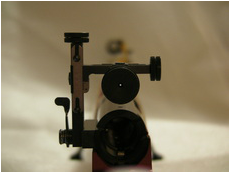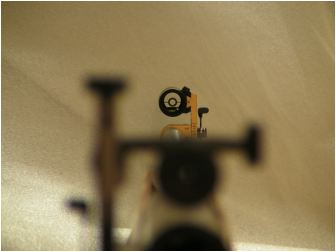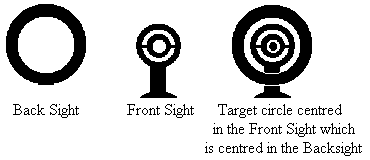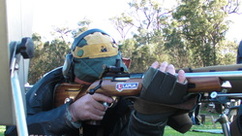|
Target Rifle
Target rifle shooting is the sports traditional shooting discipline. It is shot off the elbows with the aid of a sling attached to the rifle, using peep sights. This is form of competitive shooting originated in the mid 1800's, in both the United Kingdom and America as a way of training military and civilian persons in marksmanship. It quickly became a popular sport and as rifle technology developed so did the skill level of the competitors. By 1860 the National Rifle Association of the United Kingdom was founded and Queen Victoria fired the first shot.
Target Rifle Shooting had now become an international and highly prized sport, with the empire countries (now Commonwealth Nations) and America competing for top honours. In many Countries, such as Australia and the Commonwealth Nations, target rifle shooters complete for a Queen's Prize, the highest State and National shooting prize attainable. Akin to winning a state or national championship. Target Rifle. Fullbore Target Rifle involves a prone position (lying down), single shot precision shooting using 'iron' aperture sights at 'round bull' target at distances from 300 to 1000 yards, or 300 to 900 metres. The shooter also uses the aid of a rigid shooting coat, a sling (which is attached to the forearm / coat and to the front of the rifle to aid stability), a glove and a cap or hat (to shade the rear sight). Modern target rifles are extremely accurate, the 'iron' aperture sights are adjustable for elevation and windage. Optical Class This is type of shooting is shot off the elbow, with the aid of a sling, but with the aid of a telescopic sight. The Target Rifle
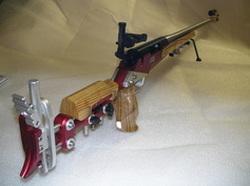
Most target rilfes are fundamentally similar, they are a a single shot, bolt action rifle, shot with a .223 or .308 calibre.
Many rifles today have the following features: An adjustable butt plate (where the rifle rests in the shoulder) Adjustable check piece, which allows for the check and head to be positioned correctly when aiming. Iron Aperture back sight
The rear sight can be adjusted for elevation, by winding the top knob (on the vertical arm of the sight), either clockwise, moving the sight upward or counter clockwise to move the sight downwards.
The sight can be moved sideways (left or right), by winding the knob on the horizontal arm away (move the sight right) and towards you to move it to the left. The sights movement are generally in parts of angle. A singular movement of the sight will move the sight part of a minute of angle. In shooting they generally refer this as a click, on this sight shown to move the sight up and down 4 clicks are required to move one minute of angle. So this sight is a 1/4 of angle of movement for elevation and windage. Generally as the distance increases the sight (elevation) is wound upwards, which makes the front of the barrel rise. Front sight
The front sight is located at the end of the barrel. The front sight can either be fixed or movable.
The movable front sight is oftern refered to as a ladder or front elevation foresight. The sight shown is a ladder sight and can be moved downwards as the ranges increase in distance. This lifts the front of the barrel while the rear sight remains in the same position. Sighting Picture
The objective of the aperture sight is to: Put the front sight ring in the centre of the rear sight, the place the black centre of the target in the centre of the inner ring of the front sight. Once black target centre and front and rear sight are all centred, as illustrated in the right hand image, the shot can be released. Once this aiming technique is mastered it is extremely accurate. Target shooter in the aim position
A right handed rifle shooter above, note the glove on the left hand, and the sling attached to the front of the rifle going back and around the left arm (at the bicep). The sling is for support and stability.
The cap is to shade the rear sight so to give a clear image of the front sight and target (aiming mark). Ear proctection is required at all times while shooting. |
FTR and F Class
F-Class shooting was the brainchild of Canadian George Farquharson and the “F” in FClass is attributed to his last name.
George's idea was to replace the iron sights with a scope, replace the sling with the option of using either a front bi-pod or a rest and to be shot from the prone position, as target rifle shooters do. The rationale behind his idea was to enable shooters that found it hard to continue shooting target rifle (shooting with the iron peep sights and off the elbows with the aid of a sling) to have the opportunity to remain and participate in their chosen sport. During the 1990's he lobbied the Canadian NRA (DCRA) for this new discipline to be adopted and in the mid 1990's F-Class begun as an official shooting sport in Canada. This discipline was quickly taken up throughout the commonwealth nations, with adoption of this discipline in Australia in November 2007. FClass is now the fastest growing discipline in our sport. At present there are three recognised F Class disciplines in Australia (governed by the NRAA, standard shooting rules) being - F Class standard, F Class open and FTR. F Class Standard
F Class is shot with the aid of a front rest or bi pod and rear bag, with aiming achieved through a telescopic sight. Under the Standard Shooting rules, two calibres can be used, 7.62mm (.308) and 5.65mm (.223). F Class Open
Commonly refered to as FOpen is also shot with the aid of a front rest or bi pod and rear bag, with aiming achieved through a telescopic sight. However this discipline allows the shooter to use any calibre up to 8mm. F T/R
F Class Target Rifle or commonly referred to as F T/R has a specific section in the NRAA standard shooting rules. F T/R differs to FOpen in three ways. Being that F T/R must use only 7.62mm (.308) and 5.65mm (.223) calibres, to be shot off a bi-pod and the total weight of rifle and attachments must be less than 8.25kg's. General rules can be viewed at http://www.icfra.co.uk/FC_Rules_2018_final.pdf Sporter Discipline (formally Hunter Class) This is the newest class in our sport and is designed to allow standard shop bought sporting type rifles. There are, however, some rules on what can be used on our range. Please contact us for details. |
